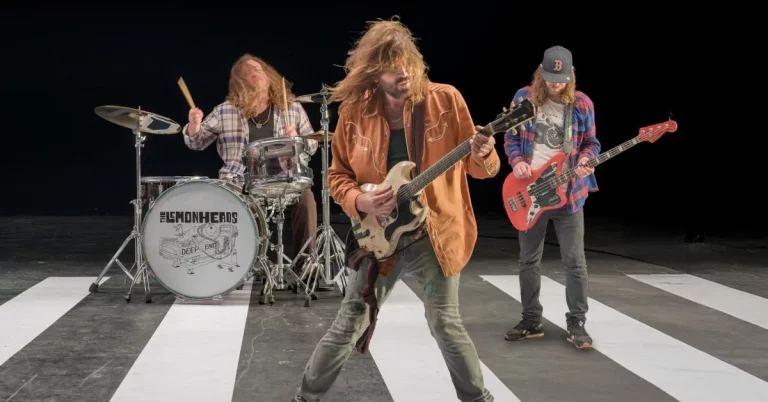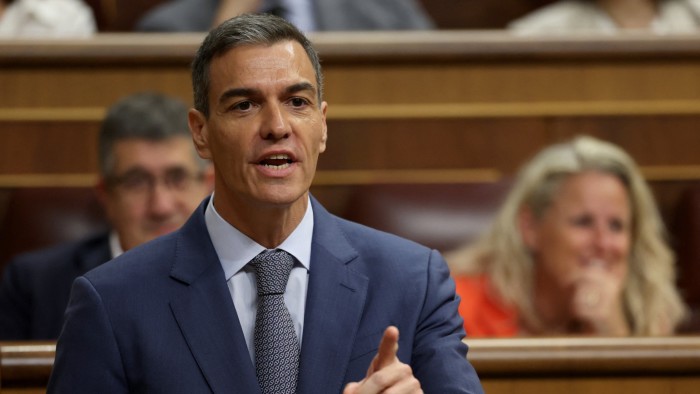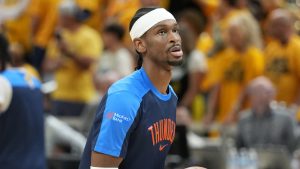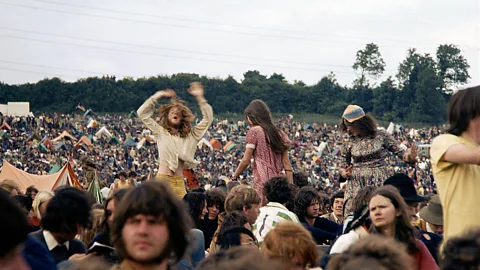 Alamy
AlamyAlmost 55 years ago, Michael Eavis hosted the first of his legendary music festivals. In 1970, the BBC visited his Somerset dairy farm to find out what made it so unique.
“I think this is the quickest way of clearing my overdraft,” said Michael Eavis on 18 September 1970 when he was asked on the BBC why he had booked glam rocker Marc Bolan to perform in his field. The dairy farmer was being interviewed on his Somerset farm, as he sat on a newly-made makeshift wooden toilet, the day before the opening of what would go on to become one of the most famous and celebrated music festivals in the world.
The Glastonbury Festival in the decades since has evolved into a vibrant, sprawling cultural extravaganza which draws the biggest names in the music business: Neil Young, Olivia Rodrigo and The 1975 are all due to headline this year. Tickets sell out within minutes, and thousands of revellers from all over the world are expected to descend on the farm’s rolling fields this week for the chance to experience the festival’s mix of music, dancing and fellowship.
But the first festival was a more modest affair and was partly driven by Eavis’s need to keep his family’s farm afloat. “It’s a means of staying in the business,” he told BBC reporter John Norman a few weeks before the first festival began. “There are people selling up all the way round here, about a dozen sold up in the last five years, and we’ve got to do something because farming is such a dead loss.”
Eavis’s family had been farming the land in Somerset, UK for well over a century. Born in 1935, he was the eldest of five siblings, and his parents, a Methodist preacher and a headmistress, had instilled in their children a strong sense of social responsibility. But even as a child, Eavis was obsessed with pop music. At boarding school at the age of nine he was punished for smuggling in a wireless so that he could listen to Radio Luxembourg at night. As an adult, despite dairy farming being tiring and time-consuming work, he still found time to indulge his passion, playing pop music to his cattle while they were being milked. “I invented a sound system, and it was all tied up with string and stuff, and wired it into my player in the dairy and it was fantastic sound. So, I played [The Kinks’ song] Lola to the cows day after day and I really enjoyed it,” he said on the BBC’s Witness History podcast in 2015.
The farmer was convinced that the cows enjoyed his music selections, too. “They do like the music very much,” he told the BBC in 1970. “We have it in the stalls and they are used to it. And it seems to be proved to me that it does, in fact, affect the yield because I had a relief milker coming in – I had to do the milking while I was doing the show – and the first day he didn’t want the wireless on, and I was 10 gallons down on production.”
Eavis had been running the farm since he was just 19, when his father died of cancer. But along with taking over Worthy Farm, Eavis had also inherited its sizable overdraft. “If you are just stuck with a farm and you are scraping along on an overdraft which it is almost impossible to meet the interest for, you’ve got to use your head and think of something else to do,” he told Norman.
It was in the summer of 1970, when the single Lola was released, that inspiration came to him. He was attending, with his future wife Jean, the Bath Festival of Blues and Progressive Music, and he was bowled over by the event’s “absolutely marvellous atmosphere”.
Marc Bolan to the rescue
“The Sun was shining, people looked fantastically beautiful, mainly hippies in great clothes and flowers in their hair, all that sort of thing, because it was the peak of the flower power era, really. There was a huge anti-Vietnam war crowd, and the songs were so moving. And with my Methodist background and slightly puritanical upbringing, it was such a transformation for me,” he told the BBC in 2015.
Eavis saw a way that he could embrace his love of music and community, solving his financial problems at the same time. “And that was it, really. I thought, ‘My God, I’ve got to do this.’ I was quite ambitious, I suppose, and slightly over-confident, I would say. So, I got on the phone the next day to find out the phone number for The Kinks.”
Having managed to track down the agent of one of his – and his cows’ – favourite bands, Eavis booked the English rock group to headline for £500, despite having no experience in organising a festival. That was until an article came out saying that The Kinks were playing what the journalist dubbed a “new mini festival”, prompting their agent to get back on the phone. “He said, ‘What are you talking about, a mini festival? My band is number one across the world.’ So, they cancelled. They didn’t like that,” Eavis told Witness History.
In History
For more stories and never-before-published radio scripts to your inbox, sign up to the In History newsletter, while The Essential List delivers a handpicked selection of features and insights twice a week.
Adding to his problems was that by the time The Kinks pulled out, the original posters for the event – then called the Pilton Pop, Folk and Blues Festival – had already been printed. Singer Wayne Fontana, known for his 1965 hit A Groovy Kind of Love, was also listed on the bill, but would end up not playing. Then Eavis had a stroke of good fortune. “But the chap said, ‘I’ve got Marc Bolan and Tyrannosaurus Rex and they are going down to Butlins [a UK Holiday resort chain] in Minehead.’ And he said, ‘I’ve looked at the route map and I think that they go by your farm, so could they do it instead?’ And I said that would be fantastic. Bolan was the father figure of the glam rock thing and [he was] a lot more trendy than The Kinks were, actually, and it was fantastic luck.”
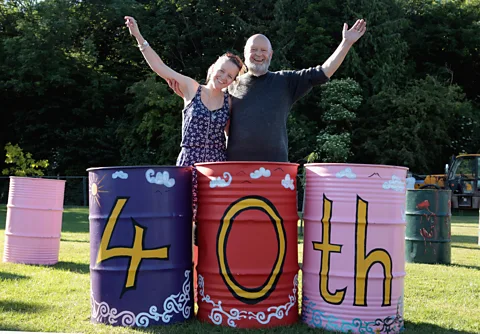 Getty Images
Getty ImagesNot everyone in the area agreed. “Satisfying all the local authorities – the police and the health and hygiene and all the departments – has been the most difficult aspect of the whole function,” Eavis admitted to the BBC in 1970. “The police tried very hard to talk me out of it in the first place. But having agreed to do it, the police realising I wouldn’t change my mind, they’ve been very cooperative since, actually. They’ve been very good.”
The controversy the festival drummed up ultimately served to promote it both to bands and music-lovers. “There was a lot of opposition to start with, it was in the paper and it was all free publicity, and so the whole show was actually publicised for nothing,” he said in 2015. “And Quintessence and all sorts of hippie bands saying could they come and play and everything. And I said, ‘Yeah, come up and join us.'”
Which was just as well, since by this time Eavis was spending hundreds of pounds turning the farm’s tranquil countryside setting into a festival venue, taking out hedges to create a natural auditorium for the bands to play in. “We got a nice slope all the way round and we’re having the stage at the bottom, and the power supply to the stage is costing us a packet, and the stage itself is quite a lot of money,” he told the BBC in 1970. But he believed that his farm was the perfect setting for a festival. “It’s a super place for it, it’s absolutely ideal. It’s a kind of a euphoria down here. You know, it’s away from the awful realities of life. It’s a nice place, the Vale of Avalon, Glastonbury and all the mystique surrounding it. It’s a nice place for it.”
A cultural phenomenon
Pilton Pop, Folk and Blues Festival opened the day after legendary guitarist Jimi Hendrix unexpectedly collapsed and died at a party in London. Eavis recalled on Witness History that many of the 1,500 people at that first festival had tears in their eyes at the news of the rock star’s death. Entry to the one-day festival cost £1 (£13.67 or $18.44 in today’s money), and festival-goers received free milk from the dairy. Worthy Farm’s kitchen doubled as a dressing room for the bands performing.
Although it didn’t attract the 5,000 attendees that the farmer had hoped for, the word-of-mouth news of his festival travelled so far that some people, believing the event to be free, had walked all the way to the farm from London. “They got to the gate and sort of flaked out at the gate, you know, and they didn’t have any money,” said Eavis in 1970. “And a fellow came up and said, ‘Well, I’ll get an announcement on the stage and we’ll have a collection for them,’ and in five minutes we had £30. It was absolutely fantastic. So, I let them all in. You couldn’t think of a more unselfish lot of people.”
But the original festival would not ultimately solve Eavis’s money worries. In fact, he made a loss on the event. He ended up paying Marc Bolan, who would go on to become one of the UK’s biggest rock stars in the early 1970s, in instalments of £100 from his milk profits for five months. “[I] really thought this might be a way of coping with the overdraft. I was so naive at the time I didn’t realise that it wasn’t all profit. I didn’t make a profit until 11 years later,” he told Witness History.
The Glastonbury Festival – the name settled on in 1979 – has in the decades since become a cultural phenomenon. It remains a celebration of music, art and the ideals behind the counterculture movements of the 1960s that so inspired Eavis. Raising money and awareness for the festival’s chosen charities is still one of the driving forces behind hosting it. And experiencing the festival has become a rite of passage for music fans and professional musicians alike, with everybody from Radiohead and Stevie Wonder to Billie Eilish and The Rolling Stones headlining on Glastonbury’s famous Pyramid Stage.
Despite not clearing his overdraft, Eavis told the BBC that he had no regrets the day after the first festival. “It was absolutely super. It was worth it. It was worth it for the success. We had people from America and Germany and all over coming and saying, ‘My God, it was fantastic.’ And it was so nice because I haven’t had any experience of it, obviously – and from the music side, apparently, it was rated with the other festivals.”
But the farmer did confess that he would “be very glad to get back to the cows again”, adding: “It’s been very, very nerve-racking and tiring.”
For more stories and never-before-published radio scripts to your inbox, sign up to the In History newsletter, while The Essential List delivers a handpicked selection of features and insights twice a week.


